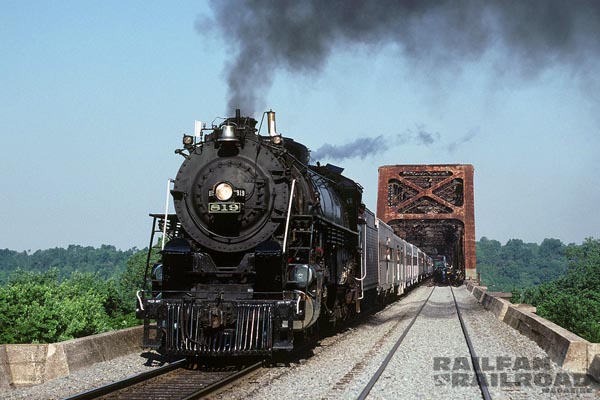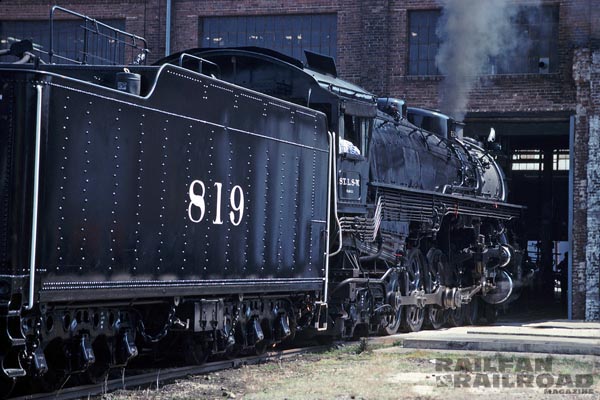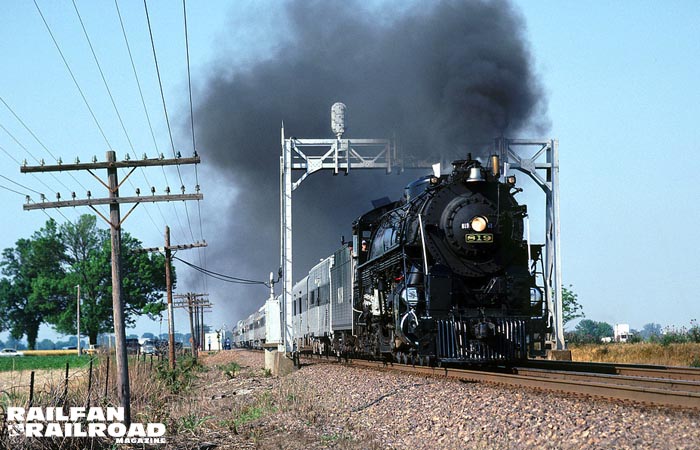By Steve Barry/photos by the author
Cotton Belt 4-8-4 No. 819 is the classic example of a steam locomotive all dressed up with no place to go. The Northern-type locomotive was built in the shops of the St. Louis-Southwestern Railroad (better known as the Cotton Belt) in Pine Bluff, Ark., in 1943, the last steam locomotive built by the railroad. It was to some extent a copy of ten Northerns that Baldwin had built for the railroad in 1930 (Nos. 800-809). Cotton Belt built five additional Northerns (Nos. 810-814) in 1937. The last five (Nos. 815-819) were slightly different from the rest, as they had steel number plates and numerals, and no chrome plating (war time restrictions were in effect). No. 819 served the Cotton Belt only slightly more than a decade, and was retired in 1955 and presented to the City of Pine Bluff to recognize the important role the town had played in the history of Cotton Belt steam.
In 1983 the locomotive was removed from display and taken back to its birthplace, the Pine Bluff shops, for restoration as an excursion locomotive. Thanks to a combined effort of historical society volunteers and railroad employees, the 819 was slowly brought back to life and returned to excursion service in 1986. In 1990 it ran to the National Railway Historical Society convention in St. Louis, taking two days to get there. My first meeting with the 819 was on June 12, 1990, as she hauled a convention special from Pine Bluff to Illmo (Scott City), Mo.

Cotton Belt 819 crosses the Mississippi River at Thebes, Ill, on June 13, 1990. Scheduled maintenance had taken the near track out of service.
The next morning the photo line was huge at the Cotton Belt bridge over the Mississippi River at Thebes, Ill. (above). Photographers were stacked about five high to get the shot. Fortunately, maintenance work had one track shut down, with the equipment parked on the bridge, so the photo line knew there would be no interference from trains.
From here the photo line quickly dispersed into all directions. The next time we caught the train was just up the road at the signal bridge in McClure, Ill. The train made several servicing stops along the way, allowing the photo line to skip ahead for additional shots. The excursion train was authorized for 55 m.p.h., so the stops were a good thing!
In St. Louis, No. 819 shared the stage with three other steam excursion stars: Norfolk & Western 2-6-6-4 No. 1218, Union Pacific 4-8-4 No. 844 and St. Louis-San Francisco (Frisco) 4-8-2 No. 1522. The quartet was parked at Union Station for the convention, and each evening you could find one or more resting along the platforms. With darkness masking the distractions of the modern world, walking along those platforms at night was like stepping back in time.

Just months away from its second retirement, No. 819 enters the old Cotton Belt shops at Pine Bluff, Ark. The locomotive is currently in the midst of an evalutation for rebuilding, but once she is dressed up again, where will she go?
My last encounter with 819 would be at the Pine Bluff shop in 1993. The locomotive was mere months away from its second “retirement.” The Cotton Belt was a wholly-owned subsidary of the Southern Pacific, which was purchased by Union Pacific in 1996, and the UP has a pretty strict policy that only its own steam locomotives can operate on its lines. Firmly entrenched on the UP, No. 819 found itself suddenly with an uncertain future. Today, the former Cotton Belt shops are the Arkansas Railroad Museum, an outgrowth of the original Cotton Belt Historical Society that banded together 1in 1983 to save the locomotive in the first place. The No. 819 is undergoing another rebuild, and is currently in the midst of a multi-year inspection and reconstruction. Where will it run once the rebuild is finished? That is the question…



